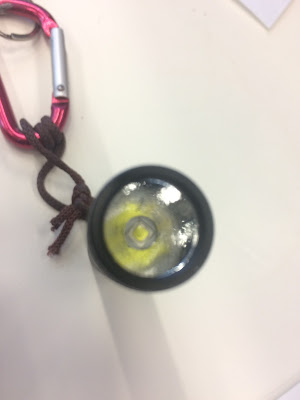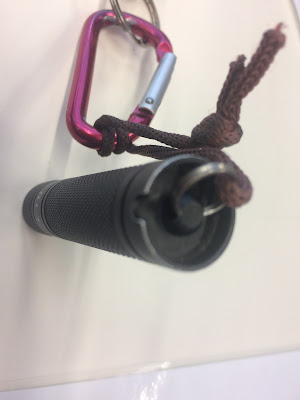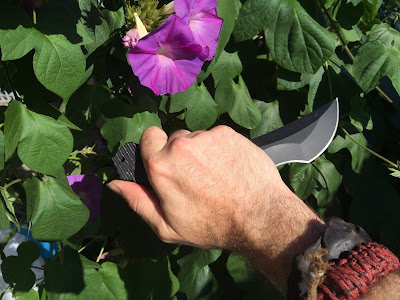 |
| Sharpie for Scale |
I liked the look of its sleek but robust design, bulkier than a pen-light and that it looked like it was designed for both pocket and PALS/MOLLE carriage. I have a Fellhoelter bolt-action pen light on my Hazard 4 chest harness (which is pretty much my principle EDC go-to), but its not much more than a "dropped my keys" or pupil-dilation checking tool.
The Wedge has a pleasant solid heft to it at 4oz (113.4g) and it fits the hand nicely, with the finger groves fall naturally into index and pointer fingers, placing the wheel button squarely under the thumb. The heel of the palm seats the butt-end of the light, tucked in securely by the pinkie finger. It measures 5 4/5"X 2/5"X ~1" (13.87 x 1.52 x 2.54 cm) overall, ( not counting the subtle pen clip ( which is reversible for lefties or righties). I tend to wear it in my front right pants pocket with the short paracord loop easily hookable for easy access. A month of daily carry has worn the anodizing of the tip, to zero functional effect.
 |
| candle Mode |
The light is activated by rolling the wheel button forward to the stable mid point, producing a bright, clear white light rated at 300 Lumen. This is the Constant-On Mode, which has a 3 hour runtime. When engaged, a small green LED behind the wheel is illuminated. This seems redundant as the main emitter LED is very clear. My own testing has the battery life lasting over 4 hours but 3 hours is a safe benchmark. The green LED shifts to red when battery life is low, which is a nice feature. Even after my 4 hour test it wasn't especially hot either which was nice, the heat-sink of the all metal body works well.
 |
| Standard mode activate |
The built-in Lithium Polymer batteries are charged via a recessed, waterproofed USB-C port in the butt of the Wedge. When charging, the behind-the-wheel LED is red until full charge at which point the indicator light goes green.
But this is where the extra distance on the wheel button comes in. If you push the wheel beyond the constant-on mid-point, you activate the THRO,
(Temporarily Heightened Regulated Output) mode. This kicks the constant-on 300 Lumen up to a dazzling 1000 Lumen output. Light throw is rated at 225' (69m) at constant-on and 360' (110m) in THRO mode. One thing that impressed me was the wide cone of light, with the main cone being around 120 degrees wide, with a secondary cone at around 160 degrees. This extra wide beam provides for an almost full room coverage from a doorway, which is very handy for those "bump in the night" investigations or "where did that battery roll under the bed" searches.
The constant-on setting is standard, with the THRO mode requiring constant forwards pressure to maintain it, such that an initial push forwards may move directly to THRO-mode then back to constant-on. This isn't too much of an issue, but I did find that some finesse was required to switch it on without moving to THRO-mode, or flickering ON/OFF. That can be a little annoying, specifically because when I want light, I want constant, stable light NOW.
Another thing I like about this light is its slim but not skinny-size making it convenient to deploy in a pocket, on a belt or even in the channels of PALS/MOLLE. Perfect for placement on a chest-rig or on a pouch. It's a snug fit, especially on a rigid surface, but that adds to the security of it's carry. The para-cord fob allows for easy draw, and just like that you have the utility of a bright sharp white light at the slide of a thumb.
The base of the light, even with its recessed USB-C charging port and pen clip sits flat nicely allowing the Wedge to be stood up in "candle mode" and given it's wide arc, it will illuminate a whole tent, room or goodly sized cave.
 |
| MOLLE carry |
The lens glass is slightly inset from the rim of the frame, offering it some measure of protection against scratches and impacts. Whilst I wouldn't recommend using it as such I suppose one could grip it like a kubaton for self defense purposes. Every tool is a weapon if your imagination can stretch far enough. It's not going to do you as a set of brass knuckles, but if you ice-pick your grip you'll make a bit of a impact focus point, even if you have to drive the switch with your pinky. Good for temple-indexing, OK for cool.
 |
| ergonomics |
I really like how the light indexes in my hand, how easy it is to activate and the sheer volume of the light it emits. It is certainly one of the most powerful lights (especially for its size) that I've had. Its sleek form factor makes it unobtrusive and easy carry and quick to deploy. My only complaint would be that the thumb switch slips back from ON to OFF too easily, if its not seated quite right. This may "wear-in" over time, and hopefully in the right direction, but isn't enough to put me off this light. I've subsequently found that flicking it to "ON" then getting my thumb of the dial reduces this stutter effect, so i'm willing to concede some user error may be in play here
One last thing, if you ever felt the need to illuminate your brain, the emitter end will fit up the standard adult nostril and will light your honker up like Rudolph. Tastes like Crayons too.












































